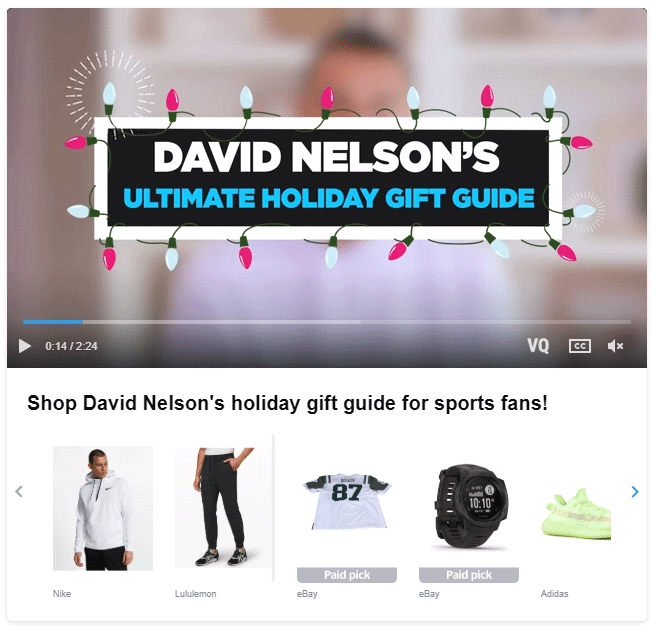When ‘shoppable’ videos become ‘bankable’
15/01/20
7'
According to Google, nearly 67% of e-shoppers say a video has inspired them to make a purchase. Videos now occupy a prominent place in the consumer’s shopping experience and certain platforms are entering a frantic race to allow advertisers to promote their product catalogue directly from their channels.
This is a key opportunity for merchants to promote their brand, products and to reach new buyers. Check out the key initiatives allowing you to broadcast your product catalogue via “shoppable” videos.
Youtube
Boasting 2 billion monthly active users (MAUs) worldwide, YouTube is the world’s leading online video platform. To illustrate this fact, 79% of internet users have a YouTube account and over a billion hours of videos are consumed daily via this channel.
Youtube provides e-merchant with different types of interactive advertising: TrueView for Shopping, TrueView for Action and Shopping Ads.
TrueView for Shopping allows advertisers to dynamically display their product catalogue in a video within Shopping Cards.
Trueview for Shopping allows advertisers to dynamically display their product catalogue within a video within “Shopping Cards”. As a video is played, an icon in the top right corner is displayed. When the internet user clicks on the icon, they discover products features in the ad, and detailed information on products they have already consulted, including an image, title, price, etc. On mobile, the display appears below the video.
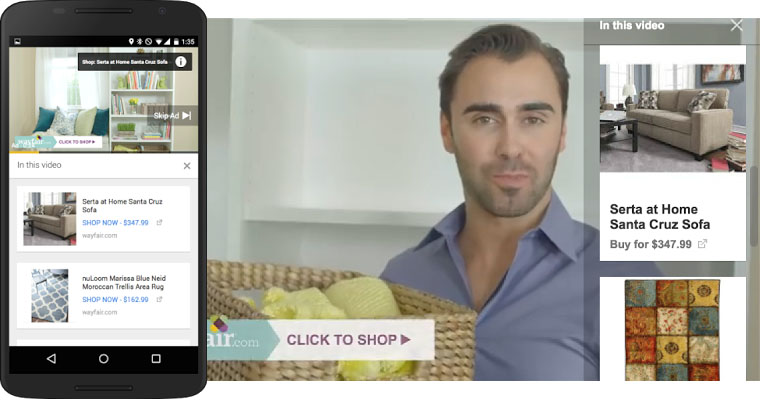
For advertisers who have other objectives than selling products, Google offers TrueView for Action. This interactive advertising format allows advertisers to add a call to action button to their ad, inviting users to: request a quote, visit your online store, make a purchase, subscribe to your newsletter, download an application, make a reservation, etc.

NB: TrueView for Action is only compatible with InStream ads. For Trueview for Shopping, advertisers can set up InStream and Video Discovery ads.
In November 2019, Google announced the arrival of Shopping Ads on YouTube. These will be deployed on YouTube’s home page and search results pages, presented in the form of a product carousel. Ads will be displayed to users’ interests and searches on the platform.
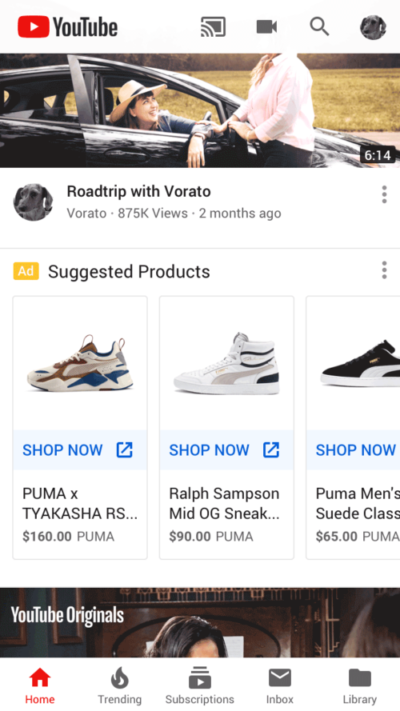
Social commerce is gaining popularity, as more and more platforms add new functionalities to support brands’ and retailers’ e-commerce objectives. Instagram is no exception, with Instagram Shopping, a functionality that allows users to shop within the platform.
Instagram offers brands and retailers different ways to showcase their products to its 1 billion monthly active users (MAUs). Instagram Shopping allows them to tag their products within publications (images and videos) or add product stickers to their Stories—viewed daily by over 500 million users—in an organic way. If a user wants to know more about the product, they click on it to be redirected to a page where they will discover an image, description, the price, and a link to your online store.
Instagram also provides its advertisers with e-commerce sponsored ads such as stories, videos, carousels or Collection. These advertising formats allow you to redirect users to your online store. For more information, visit Instagram.
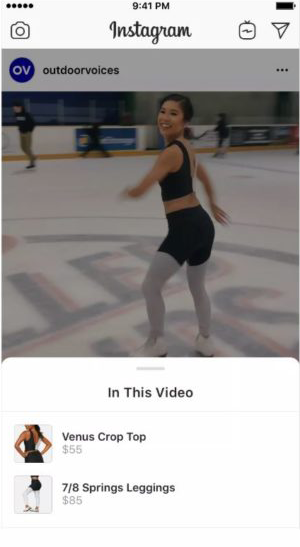
Whatever the format, Instagram allows its users to learn more about your products (title, price and description) before placing an order. Soon merchants will also be able to offer buyers to finalize their purchases directly within the social platform with the payment functionality “Checkout on Instagram”. For the moment, this functionality is being tested in the U.S. by a handful of companies.
Facebook Inc.’s “shoppable” video projects continue to multiply. According to Bloomberg, the American giant is about to launch a live commerce feature on its marketplace that will allow users to make purchases while watching live videos.
TikTok (Douyin)
This mobile application for creating and sharing short videos currently has 625 MAUs. To introduce products to this community of mostly Generation Z users, brands have access to a number of e-commerce features on TikTok.
Soon, these brands will also be able to sell their products through a new channel: influencers. They will be able to integrate links within their videos to redirect users to an online store.
Currently available in beta version in the United States, this new feature (already available on Douyin, the Chinese version of the application), will strengthen the influential marketing already very present on this platform.
Verizon Media
Verizon Media is committed to building a customer buying journey unified by content, through adapted native advertising, from discovery to transaction.
To mark the 2019 holiday season, Yahoo (one of Verizon Media’s editorial sites) and eBay created a campaign combining content and commerce called “The Guy’s Guide to Nailing the Holidays”. This campaign consists of providing gift ideas to men through a series of videos featuring influencers from different universes: lifestyle, tech, sport, gaming, etc.
As they view the videos, users discover the eBay products put forward by influencers. The products appear below the video in a carousel format and are framed in grey as the influencer presents the product. eBay is the first advertising partner to sponsor Verizon Media’s new video format. The format is expected to become more widespread in the coming months as, since this announcement, Verizon Media has already renewed this feature by working with tennis champion Serena Williams to launch her new collection.
Snapchat
Snapchat provides marketers with different advertising formats to reach the 210 million DAUs on its platform. Some of them allow merchants to showcase their product catalogue by publishing sponsored images and/or videos in the formats Product Ads, composed of Story Ads, Snap Ads, and Collection Ads.
Story Ads allow advertisers to reach buyers in the “Discover” section of Snapchat. To attract users’ attention, this advertisement must be composed of an attractive image and title. Advertisers can then include between 3 and 20 Snaps and add links to their e-commerce site to generate sales.
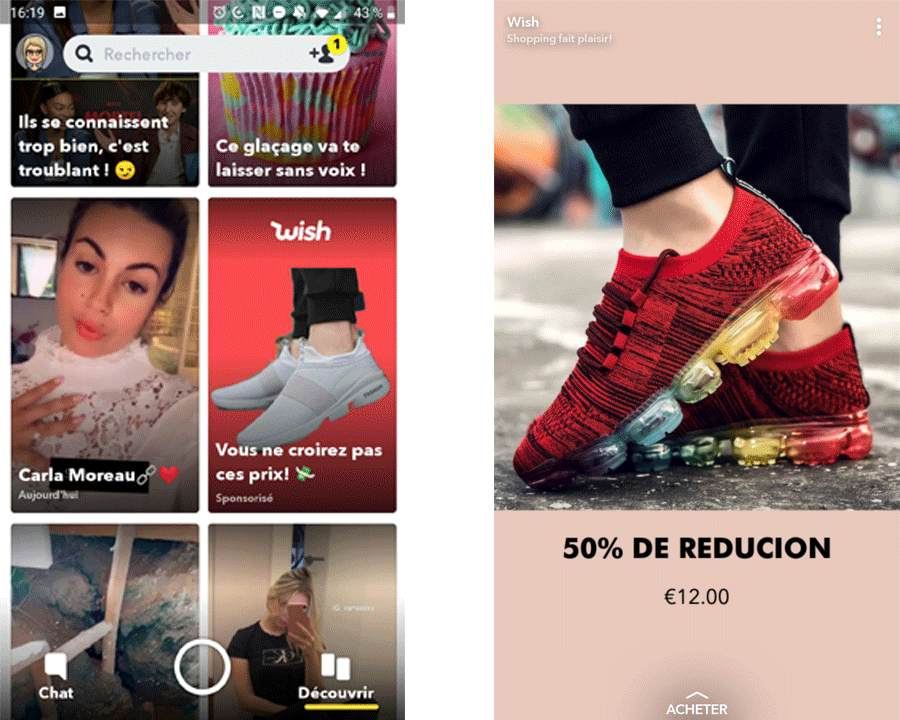
Snap Ads are displayed within user stories. When a user discovers your ad, they are invited to swipe and are then redirected to a site or an e-commerce application, enabling them to order the product present in the ad.
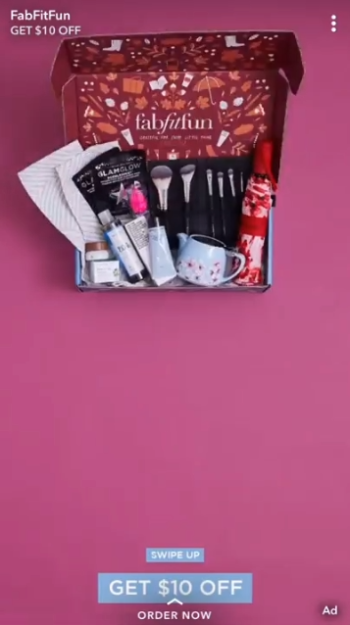
Finally, marketers can exploit Collection Ads. In this ad format, your video is accompanied by four product thumbnails. If one a user would like to know more about one of these products, they simply click on the thumbnail to go to the product page and buy it.
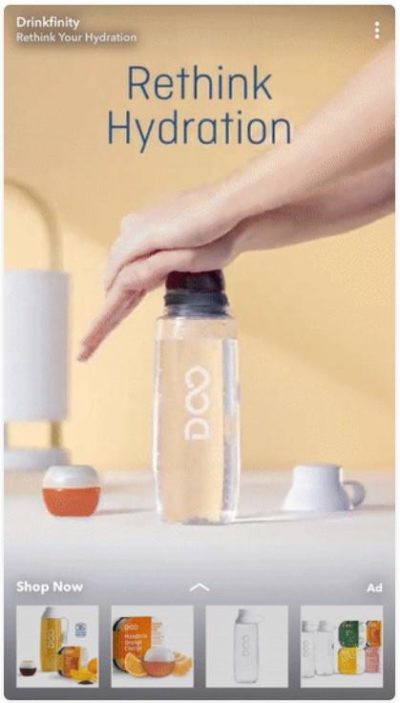
With the rise of “shoppable” video content, we are entering a new era of native e-commerce in which brands and retailers have a bright future ahead of them. The opportunities to promote products are multiplying and the means for consumers to share their shopping experience on social platforms is sure to develop in the coming years.
Your e-commerce library
Sign up for our newsletter
By submitting this form you authorize Lengow to process your data for the purpose of sending you Lengow newsletters . You have the right to access, rectify and delete this data, to oppose its processing, to limit its use, to render it portable and to define the guidelines relating to its fate in the event of death. You can exercise these rights at any time by writing to dpo@lengow.com

Trending Posts
Marketing channels
ChatGPT Ads and advertising on GenAI Search Engines: what you need to know
Advertising on generative AI-based search engines (GenAI) marks a new era in digital marketing. After two decades dominated by traditional…
22/05/25
6'
Marketing channels
Reddit and Social Commerce: When Users Take Back Control
Before buying anything, we compare. We hesitate. And more and more often, we end up typing the product name followed…
30/06/25
8'
Marketing channels
How to Sell on TikTok in 2025: The Ultimate Guide to Success
To sell or not to sell on TikTok? That remains a question many brands ask themselves. But here’s what you…
03/02/25
7'
E-commerce Trends
E-Commerce 2025: The New Rules of Digital Retail
What’s going on in e-commerce? A lot. If 2024 was the year brands got comfortable with marketplaces, AI tools, and…
11/07/25
8'
Marketing channels
Omnichannel Strategy: The Best Examples of Successful Brands
Consumers interact with brands through multiple channels, including online, in-store, and mobile apps. More than 90% of consumers expect a…
04/04/25
5'





